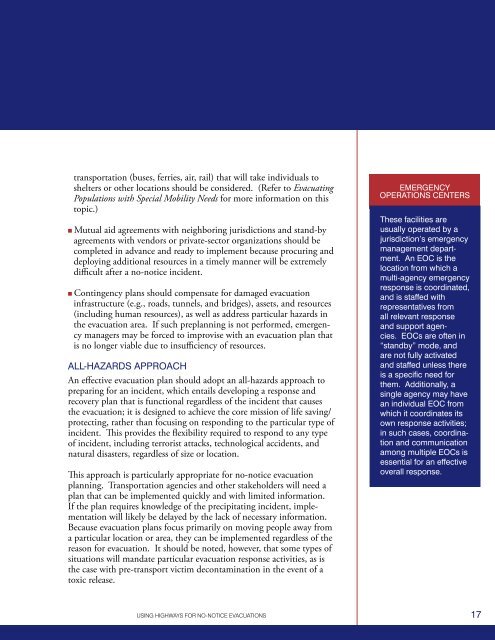using highways for no-notice evacuations - FHWA Operations - U.S. ...
using highways for no-notice evacuations - FHWA Operations - U.S. ...
using highways for no-notice evacuations - FHWA Operations - U.S. ...
Create successful ePaper yourself
Turn your PDF publications into a flip-book with our unique Google optimized e-Paper software.
transportation (buses, ferries, air, rail) that will take individuals toshelters or other locations should be considered. (Refer to EvacuatingPopulations with Special Mobility Needs <strong>for</strong> more in<strong>for</strong>mation on thistopic.)n Mutual aid agreements with neighboring jurisdictions and stand-byagreements with vendors or private-sector organizations should becompleted in advance and ready to implement because procuring anddeploying additional resources in a timely manner will be extremelydifficult after a <strong>no</strong>-<strong>no</strong>tice incident.n Contingency plans should compensate <strong>for</strong> damaged evacuationinfrastructure (e.g., roads, tunnels, and bridges), assets, and resources(including human resources), as well as address particular hazards inthe evacuation area. If such preplanning is <strong>no</strong>t per<strong>for</strong>med, emergencymanagers may be <strong>for</strong>ced to improvise with an evacuation plan thatis <strong>no</strong> longer viable due to insufficiency of resources.All-hazards approachAn effective evacuation plan should adopt an all-hazards approach topreparing <strong>for</strong> an incident, which entails developing a response andrecovery plan that is functional regardless of the incident that causesthe evacuation; it is designed to achieve the core mission of life saving/protecting, rather than foc<strong>using</strong> on responding to the particular type ofincident. This provides the flexibility required to respond to any typeof incident, including terrorist attacks, tech<strong>no</strong>logical accidents, andnatural disasters, regardless of size or location.This approach is particularly appropriate <strong>for</strong> <strong>no</strong>-<strong>no</strong>tice evacuationplanning. Transportation agencies and other stakeholders will need aplan that can be implemented quickly and with limited in<strong>for</strong>mation.If the plan requires k<strong>no</strong>wledge of the precipitating incident, implementationwill likely be delayed by the lack of necessary in<strong>for</strong>mation.Because evacuation plans focus primarily on moving people away froma particular location or area, they can be implemented regardless of thereason <strong>for</strong> evacuation. It should be <strong>no</strong>ted, however, that some types ofsituations will mandate particular evacuation response activities, as isthe case with pre-transport victim decontamination in the event of atoxic release.EMERGENCYOPERATIONS CENTERSThese facilities areusually operated by ajurisdiction’s emergencymanagement department.An EOC is thelocation from which amulti-agency emergencyresponse is coordinated,and is staffed withrepresentatives fromall relevant responseand support agencies.EOCs are often in“standby” mode, andare <strong>no</strong>t fully activatedand staffed unless thereis a specific need <strong>for</strong>them. Additionally, asingle agency may havean individual EOC fromwhich it coordinates itsown response activities;in such cases, coordinationand communicationamong multiple EOCs isessential <strong>for</strong> an effectiveoverall response.USING HIGHWAYS FOR NO-NOTICE EVACUATIONS17
















